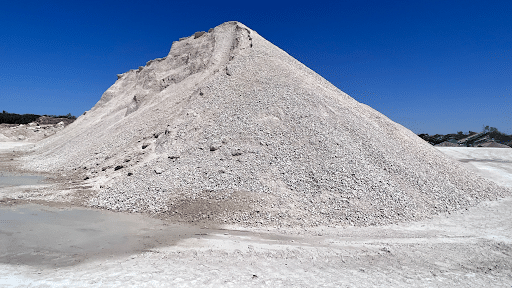The Variation of Gradations in Bases
In the world of construction, the variation of gradations in bases plays a crucial role in determining the strength and stability of structures. Understanding the different gradations of bases, such as limestone, is essential for selecting the right materials that meet the specific requirements of your project and ensure its long-term durability.

Flex Base
Flex Base, known by many names like road base or standard base, is a versatile material commonly used in construction projects. It is typically composed of crushed limestone and is categorized by specific gradations and metrics. The gradations for flex base range from the smallest sizes,¾”, to larger sizes, like 4 inches or less. ¾”- base is typically the cheapest base offered in our operating area. The selection of a specific gradation depends on factors such as the intended application, load-bearing requirements, and desired compaction properties. By carefully considering the metrics and numbers associated with flex base gradations, construction professionals can ensure optimal performance and longevity for their projects.
Commercial Base
The commercial base, with its specific gradations and metrics, plays a vital role in commercial construction. Typically consisting of crushed limestone, it offers a strong foundation for various structures. The gradations for commercial bases can range from 1 ¾” inch to 3 inches, providing excellent load-bearing capacity and compaction properties. This makes the commercial base ideal for applications such as parking lots, roads, and industrial areas, and other commercial building jobs that require materials where durability and stability are paramount. Commercial base is often city approved but is rarely used if at all on state projects.
State Spec Base
State Spec Base is a specialized type of base material that meets the specific requirements and standards set by state regulations. It typically consists of crushed limestone with precise gradations and metrics. The gradations for State Spec Base can vary, ranging from smaller sizes like ¾ inch to larger sizes such as 2 inches, depending on the state specifications. State Spec Base is commonly used for highway construction, roadways, and other infrastructure projects, ensuring compliance with state guidelines and providing a sturdy foundation with optimal load-bearing capacity.
Spec 247 Base
Spec 247 Base typically consists of crushed limestone with precise gradations and metrics, such as 1 ½ inches or less in size. Spec 247 Base is particularly well-suited for applications where a strong, stable, and compacted base is necessary, such as under pavements, roadways, and heavy-duty commercial areas. Its adherence to the specified metrics ensures optimal performance and meets the rigorous standards set for construction projects requiring durable and reliable base materials.
Grade 4 Base
Grade 4 Base is a type of base material commonly used in construction projects. It typically consists of crushed limestone with specific gradations, such as 2 ½ inches or less in size. The advantages of Grade 4 Base include its ability to provide good stability and load-bearing capacity. Grade 4 Base has the same compaction standards as grades 1-2, although it may not be suitable for applications where a finer or smoother surface is desired, though this is one of the better options for a more stable load-bearing capacity.
Grade 3 Base
Grade 3 Base construction material offers cost-effective advantages, making it an ideal choice for projects with budget constraints. Its larger gradations contribute to improved permeability, facilitating proper water drainage and mitigating erosion risks. This is the finest material as it allows for only 50% of the rock to be retained on a number 40 sieve (.425 mm), while the requirements on how much should be retained on a number 4 sieve (4.75mm) remains the same as grade 1-2. Because this tends to be on the finer side and often contains more dirt and rock it can get muddy if used in an area with minimal water drainage
Grade 2 Base
Grade 2 Base construction material has several advantages, including good load-bearing capacity, effective compaction properties, and adequate drainage. With gradations commonly ranging from 1 1/2 inches to 3/4 inches in size, it provides a versatile foundation for various construction projects. However, one potential drawback is that it may not offer as high load-bearing capacity as larger-grade base materials, and it may require more compaction efforts compared to finer base materials.
Grade 1-2 Base
Grades 1 and 2 spec 247 TxDOT base requirements were combined in 2014, so effectively grade 1 and 2 base are the same.Grade 1-2 base is 1 and ¾”. Grade 1-2 tends to contain larger rocks as it requires at least 10-35% to be larger than 7/8ths of an inch, and 30-65% to be larger than 3/8ths of an inch. Grade 3 has no requirements of this sieve, just that 45% to 75% be larger than 4.75 mm thus resulting in Grade 1-2 being a much larger base. In Grade 1-2 it allows for 10-35% to be smaller than .425 mm and in grade 3 it allows for 15-50% to be smaller than .425 mm.
Grade 1 Base
Grade 1 Base is a high-quality construction material commonly used in various projects. It typically consists of crushed limestone with specific gradations, often ranging from 3/4 inch to 1 1/2 inches in size. The advantages of Grade 1 Base include its compatibility, good drainage properties, and excellent load-bearing capacity. However, its smaller size may require additional compaction efforts, and it may not be as visually appealing for applications where aesthetics are important.
Keep in mind:
Type A
Crushed Base, in the Waco/Austin areas will be limestone or granite base.
Type B
Can be smooth aggregate or mix of smooth and crushed from multiple sources.
Type C
2 sides of the rock must be crushed with 60% being larger than 4.75 mm. Can use multiple sources.
Type D
Crushed concrete or Type A.